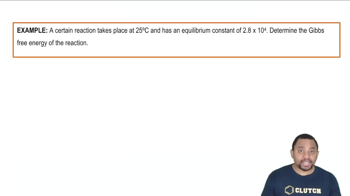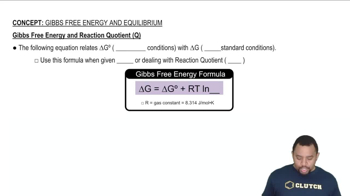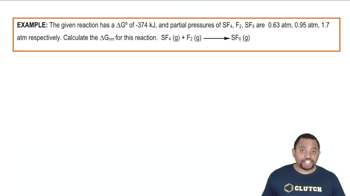19. Chemical Thermodynamics
Gibbs Free Energy And Equilibrium
19. Chemical Thermodynamics
Gibbs Free Energy And Equilibrium
Practice this topic
- Multiple Choice
For reaction, Ag2CO3 (s) ⇌ Ag2O (s) + CO2 (g), the ∆Hº = 79.14 kJ/mol, ∆Sº = 167.2 J/K.
Determine the equilibrium constant at which the temperature is 365.1 K.
392views1rank1comments - Multiple Choice
Consider a hypothetical reaction at 38 ºC, X2 (aq) + 2 Y (s) ⇌ 3 Z (aq), with a ∆G of −75.8 kJ.
Concentrations of reactants and products: [X2] = 1.4 M, [Y] = 0.34 M, [Z] = 2.6 M. Calculate Keq of this given reaction.
383views4rank2comments - Open Question
NaHCO3 ⇌ NaOH(s) + CO2(g) Calculate the value of the equilibrium constant.
229views - Open Question
Calculate the equilibrium constant at 25°C for a reaction for which ∆G° = -4.22 kcal/mol.
181views - Open Question
What is δg° for the following reaction at 25 °C? COBr2(g) ⇌ CO(g) + Br2(g) Kp = 4.11 × 104
174views - Open Question
When two reactions are coupled in a cell, what determines if they will both proceed spontaneously?
216views - Multiple ChoiceA redox reaction has an equilibrium constant of K = 1.2 x 10^3. Which statement is true regarding ΔG°_rxn and E°_cell for this reaction?4views
- Multiple ChoiceAt 1120 K, ΔG° = 78.9 kJ/mol for the reaction 3 A (g) + B (g) → 2 C (g). If the partial pressures of A, B, and C are 11.5 atm, 8.60 atm, and 0.510 atm respectively, what is the Gibbs free energy change (ΔG) for this reaction under these conditions?10views




